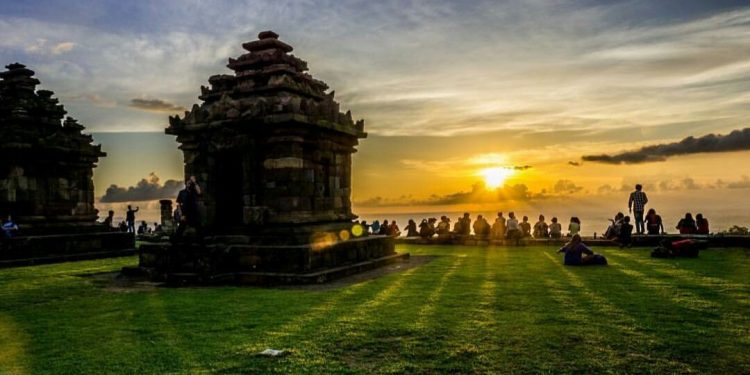Ijo Temple is a temple that is located the highest in Yogyakarta, presenting natural and cultural charms. This temple is what makes the Adisutjipto Airport runway unable to be extended to the east.
Down the road to the southern part of the Ratu Boko Palace complex is an exciting journey, especially for cultural tourism lovers.
How not, the temple buildings there are scattered like mushrooms in the rainy season. One of them that has not been discussed much is Ijo Temple, a temple that is located the highest among other temples in the Special Region of Yogyakarta.
Ijo Temple was built around the 9th century, on a hill known as Bukit Hijau or Gumuk Ijo which is about 410 m above sea level.
Because of its height, it is not only the temple building that can be enjoyed but also the natural scenery below, in the form of terraces such as in an agricultural area with a steep slope. Although it is not a fertile area, the natural scenery around the temple is very beautiful to enjoy.
The temple complex consists of 17 structures divided into 11 terraces. The first terrace as well as the courtyard leading to the entrance is a terraced terrace that stretches from west to east. The buildings on the 11th terrace are in the form of a fence, eight phallus pegs, four buildings, namely the main temple, and three ancillary temples. Laying the building on each terrace is based on its sacredness. The building on the highest terrace is the most sacred.
Various forms of fine art can be found since the entrance to the building which is classified as a Hindu temple.
Right above the entrance is a Kala Makara with a double head motif and some of its attributes. The double head motif and its attributes that can also be found in Buddhist temples indicate that a temple is a form of acculturation of Hindu and Buddhist culture.
Several temples that have similar Kala Makara motifs include Ngawen, Plaosan, and Sari.
There is also a statue depicting a female and a male figure floating and pointing to a certain side. This figure can have several meanings. First, as a suwuk to exorcise evil spirits and secondly as a symbol of the unity of Lord Shiva and Dewi Uma. This unity is interpreted as the beginning of the creation of the universe. Unlike the statues at Prambanan Temple, the naturalist style of the statues at Ijo Temple does not lead to eroticism.
Towards the ancillary temple building on the 11th terrace, there is a place like a sacrificial fire (homa). Right at the top of the back wall of the tub, there are air holes or vents in the form of parallelograms and triangles. The existence of the sacrificial fireplace is a reflection of Hindu society that worships Brahma. Three Perwara temples show people’s respect for Hindu Trimurti, namely Brahma, Shiva, and Whisnu.
One of the works that keep a mystery is two inscriptions located in the temple building on the 9th terrace. One of the inscriptions coded F with the inscription Guywan or Bluyutan means hermitage. Another inscription made of stone measuring 14 cm high and 9 cm thick contains incantations that are thought to be cursed.
The mantra was written 16 times and one of which reads “Om Sarwwawinasa, Sarwwawinasa.”
It could be that the two inscriptions are closely related to certain events in Java at that time.
Visiting this temple, you can find beautiful views that will not be found in other temples. When facing west and looking down, you can see planes taking off and landing at Adisutjipto Airport.
This view can be found because the Thousand Mountains on which the temple stands is the eastern boundary of the airport. Because of the existence of the temple in the mountains, the Adisutjipto Airport runway cannot be extended to the east.
Every detail of the temple presents something meaningful and invites the audience to reflect so that a tour is not just a fun event.
The existence of many great works of art without the name of the creator shows the view of the Javanese people at that time which focused more on the moral message carried by a work of art, not the creator or the splendor of the artwork.



